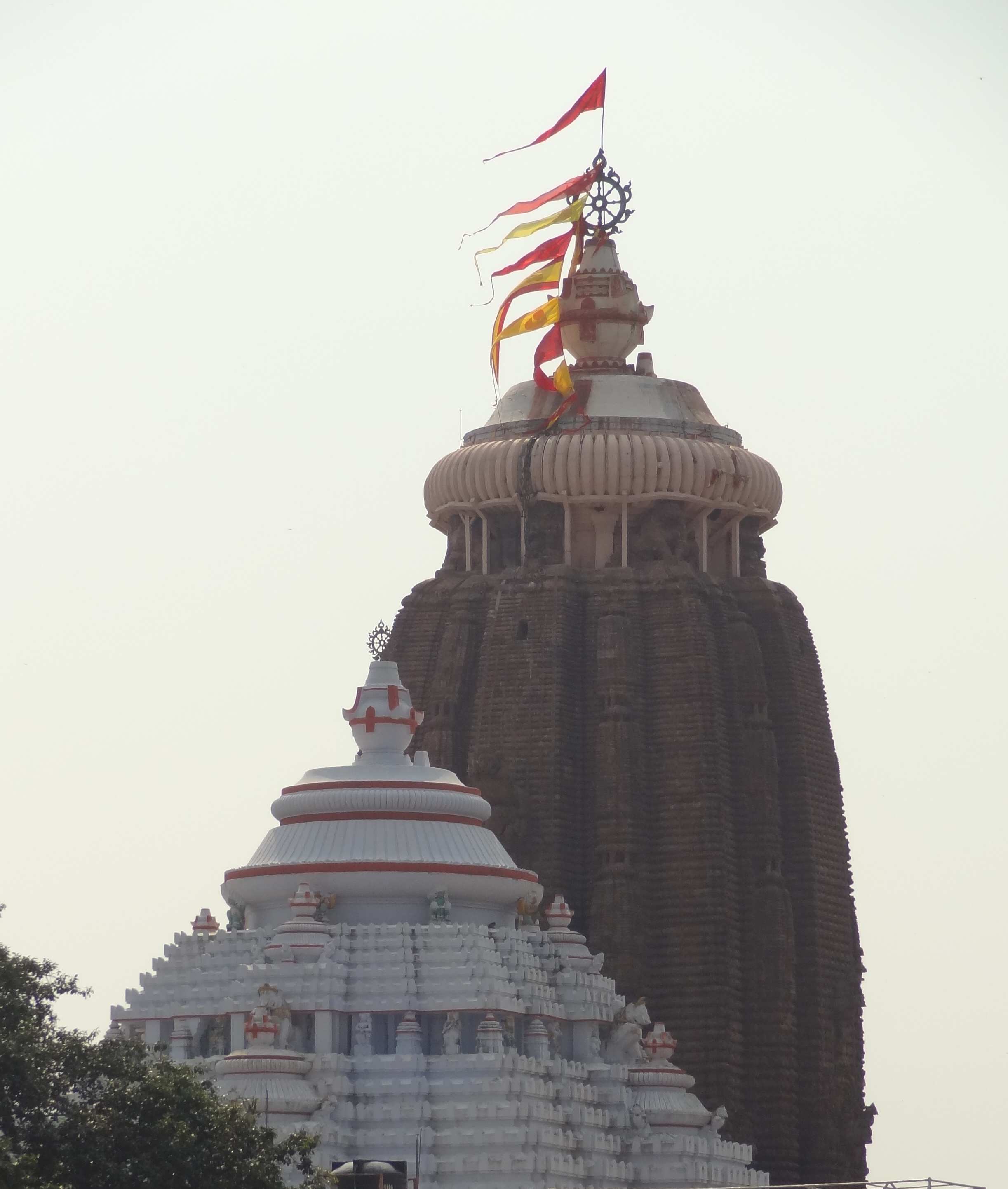|
Annakoteshvara Temple
Annakoteshwara Temple, Annakoteswar Temple, or Annakotisvara Siva Temple is located in Latadeipur in Gondia tehsil in Dhenkanal district, Odisha, India. The Temple is dedicated to Lord Shiva with a stone shivalinga. Architecture The temple is a pancharatha temple having Rekha deula (Vimana) and a Pidha deula. The temple is decorated with Khakharamundi and Pidhamundis along the main Vimana. Several detached sculptures are kept in care. On the basis of construction the temple can be said to be built around 16th century during Suryavamsi Gajapati rule. The Garbhagriha houses a circular Yonipeetha only. The Lingamurthy is displaced by attacks of Kalapahad who was a Muslim invader from the nawabs of Bengal near Murshidabad. The temple is listed as a monument by the Archaeological Survey of India The Archaeological Survey of India (ASI) is an Indian government agency that is responsible for archaeological research and the conservation and preservation of cultural historical m ... [...More Info...] [...Related Items...] OR: [Wikipedia] [Google] [Baidu] |
Odisha
Odisha (English: , ), formerly Orissa ( the official name until 2011), is an Indian state located in Eastern India. It is the 8th largest state by area, and the 11th largest by population. The state has the third largest population of Scheduled Tribes in India. It neighbours the states of Jharkhand and West Bengal to the north, Chhattisgarh to the west, and Andhra Pradesh to the south. Odisha has a coastline of along the Bay of Bengal in Indian Ocean. The region is also known as Utkala and is also mentioned in India's national anthem, " Jana Gana Mana". The language of Odisha is Odia, which is one of the Classical Languages of India. The ancient kingdom of Kalinga, which was invaded by the Mauryan Emperor Ashoka (which was again won back from them by King Kharavela) in 261 BCE resulting in the Kalinga War, coincides with the borders of modern-day Odisha. The modern boundaries of Odisha were demarcated by the British Indian government when Orissa Province was es ... [...More Info...] [...Related Items...] OR: [Wikipedia] [Google] [Baidu] |
Linga
A lingam ( sa, लिङ्ग , lit. "sign, symbol or mark"), sometimes referred to as linga or Shiva linga, is an abstract or aniconic representation of the Hindu god Shiva in Shaivism. It is typically the primary ''murti'' or devotional image in Hindu temples dedicated to Shiva, also found in smaller shrines, or as self-manifested natural objects. It is often represented within a disc-shaped platform, the '' yoni'' – its feminine counterpart, consisting of a flat element, horizontal compared to the vertical lingam, and designed to allow liquid offerings to drain away for collection. Together, they symbolize the merging of microcosmos and macrocosmos, the divine eternal process of creation and regeneration, and the union of the feminine and the masculine that recreates all of existence. The original meaning of ''lingam'' as "sign" is used in Shvetashvatara Upanishad, which says "Shiva, the Supreme Lord, has no liūga", liuga ( sa, लिऊग ) meaning he is tra ... [...More Info...] [...Related Items...] OR: [Wikipedia] [Google] [Baidu] |
Hindu Temples In Dhenkanal District
Hindus (; ) are people who religiously adhere to Hinduism.Jeffery D. Long (2007), A Vision for Hinduism, IB Tauris, , pages 35–37 Historically, the term has also been used as a geographical, cultural, and later religious identifier for people living in the Indian subcontinent. The term ''"Hindu"'' traces back to Old Persian which derived these names from the Sanskrit name ''Sindhu'' (सिन्धु ), referring to the river Indus. The Greek cognates of the same terms are "''Indus''" (for the river) and "''India''" (for the land of the river). The term "''Hindu''" also implied a geographic, ethnic or cultural identifier for people living in the Indian subcontinent around or beyond the Sindhu (Indus) River. By the 16th century CE, the term began to refer to residents of the subcontinent who were not Turkic or Muslims. Hindoo is an archaic spelling variant, whose use today is considered derogatory. The historical development of Hindu self-identity within the local ... [...More Info...] [...Related Items...] OR: [Wikipedia] [Google] [Baidu] |
Archaeological Survey Of India
The Archaeological Survey of India (ASI) is an Indian government agency that is responsible for archaeological research and the conservation and preservation of cultural historical monuments in the country. It was founded in 1861 by Alexander Cunningham who also became its first Director-General. History ASI was founded in 1861 by Alexander Cunningham who also became its first Director-General. The first systematic research into the subcontinent's history was conducted by the Asiatic Society, which was founded by the British Indologist William Jones on 15 January 1784. Based in Calcutta, the society promoted the study of ancient Sanskrit and Persian texts and published an annual journal titled ''Asiatic Researches''. Notable among its early members was Charles Wilkins who published the first English translation of the '' Bhagavad Gita'' in 1785 with the patronage of the then Governor-General of Bengal, Warren Hastings. However, the most important of the society's ach ... [...More Info...] [...Related Items...] OR: [Wikipedia] [Google] [Baidu] |
Murshidabad
Murshidabad fa, مرشد آباد (, or ) is a historical city in the Indian state of West Bengal. It is located on the eastern bank of the Bhagirathi River, a distributary of the Ganges. It forms part of the Murshidabad district. During the 18th century, Murshidabad was a prosperous city. It was the capital of the Bengal Subah in the Mughal Empire for seventy years, with a jurisdiction covering modern-day Bangladesh and the Indian states of West Bengal, Bihar and Orissa. It was the seat of the hereditary Nawab of Bengal and the state's treasury, revenue office and judiciary. Bengal was the richest Mughal province. Murshidabad was a cosmopolitan city. Its population peaked at 10,000 in the 1750s. It was home to wealthy banking and merchant families from different parts of the Indian subcontinent and wider Eurasia, including the Jagat Seth and Armenians. European companies, including the British East India Company, the French East India Company, the Dutch East India ... [...More Info...] [...Related Items...] OR: [Wikipedia] [Google] [Baidu] |
Bengal
Bengal ( ; bn, বাংলা/বঙ্গ, translit=Bānglā/Bôngô, ) is a geopolitical, cultural and historical region in South Asia, specifically in the eastern part of the Indian subcontinent at the apex of the Bay of Bengal, predominantly covering present-day Bangladesh and the Indian state of West Bengal. Geographically, it consists of the Ganges-Brahmaputra delta system, the largest river delta in the world and a section of the Himalayas up to Nepal and Bhutan. Dense woodlands, including hilly rainforests, cover Bengal's northern and eastern areas, while an elevated forested plateau covers its central area; the highest point is at Sandakphu. In the littoral southwest are the Sundarbans, the world's largest mangrove forest. The region has a monsoon climate, which the Bengali calendar divides into six seasons. Bengal, then known as Gangaridai, was a leading power in ancient South Asia, with extensive trade networks forming connections to as far away as Roman Egypt ... [...More Info...] [...Related Items...] OR: [Wikipedia] [Google] [Baidu] |
Nawab
Nawab (Balochi: نواب; ar, نواب; bn, নবাব/নওয়াব; hi, नवाब; Punjabi : ਨਵਾਬ; Persian, Punjabi , Sindhi, Urdu: ), also spelled Nawaab, Navaab, Navab, Nowab, Nabob, Nawaabshah, Nawabshah or Nobab, is a Royal title indicating a sovereign ruler, often of a South Asian state, in many ways comparable to the western title of Prince. The relationship of a Nawab to the Emperor of India has been compared to that of the Kings of Saxony to the German Emperor. In earlier times the title was ratified and bestowed by the reigning Mughal emperor to semi-autonomous Muslim rulers of subdivisions or princely states in the Indian subcontinent loyal to the Mughal Empire, for example the Nawabs of Bengal. The title is common among Muslim rulers of South Asia as an equivalent to the title Maharaja. "Nawab" usually refers to males and literally means ''Viceroy''; the female equivalent is " Begum" or "''Nawab Begum''". The primary duty of a Nawab wa ... [...More Info...] [...Related Items...] OR: [Wikipedia] [Google] [Baidu] |
Kalapahad
Kalapahar ( bn, কালাপাহাড়; died 24 April 1583), also known by his daak naam Raju ( bn, রাজু), was a military general of the Sultanate of Bengal under the Karrani dynasty. He is credited for conquering Orissa, which remained under Muslim rule up until the British conquest of India. Family and background Kalapahar was born in the 16th-century. The contemporary ''Makhzan-i-Afghani'' by Khwaja Niamatullah mentions his alias being "Raju", from which the orientalists Heinrich Blochmann and Henry Beveridge deduce a Hindu origin, and this is also backed up by local folklore. The colonial administrator and author Edward Albert Gait further describes him as a "Brahman renegade". Military campaigns With the growing influence of the Mughal Empire, the Sultan of Bengal, Sulaiman Khan Karrani, decided to send an expedition to annex Orissa under the leadership of his son Bayazid Khan Karrani and general Kalapahar. They defeated and killed King Mukunda Deva. K ... [...More Info...] [...Related Items...] OR: [Wikipedia] [Google] [Baidu] |
Yoni
''Yoni'' (; sometimes also ), sometimes called ''pindika'', is an abstract or aniconic representation of the Hindu goddess Shakti. It is usually shown with ''linga'' – its masculine counterpart. Together, they symbolize the merging of microcosmos and macrocosmos, the divine eternal process of creation and regeneration, and the union of the feminine and the masculine that recreates all of existence. The ''yoni'' is conceptualized as nature's gateway of all births, particularly in the esoteric Kaula and Tantra practices, as well as the Shaktism and Shaivism traditions of Hinduism. ''Yoni'' is a Sanskrit word that has been interpreted to literally mean the "womb", the "source", and the female organs of generation., Quote: "Yoni- 'womb, vulva', Yoni- "way, abode' is from a second PIE root ..; It also connotes the female sexual organs such as "vagina", "vulva", and "uterus", or alternatively to "origin, abode, or source" of anything in other contexts. For example, the Vedanta ... [...More Info...] [...Related Items...] OR: [Wikipedia] [Google] [Baidu] |
Dhenkanal District
Dhenkanal district is one of the 30 districts of the state of Odisha in Eastern India. Geography Dhenkanal district is one of the centrally located districts in Odisha. It lies between Longitude: 85° 58' to 86° 2' East and Latitude: 20° 29' to 21° 11' North. The nearest airport is Biju Patnaik Airport located at a distance of 52.12 Km. It is bordered by Kendujhar and Angul districts to the north, Jajpur district to the east, Cuttack district to the south and Angul district to the west. The district comprises mainly plains, however there are several discontinuous hill ranges in the district and along its southern border. The Brahmani River is the main river of the district. Demographics According to the 2011 census Dhenkanal district has a population of 1,192,811, roughly equal to the nation of Timor-Leste or the US state of Rhode Island. This gives it a ranking of 400th in India (out of a total of 640). The district has a population density of . Its popula ... [...More Info...] [...Related Items...] OR: [Wikipedia] [Google] [Baidu] |
Garbhagriha
A ''garbhagriha'' or ''sannidhanam'' is the '' sanctum sanctorum'', the innermost sanctuary of a Hindu and Jain temples where resides the ''murti'' (idol or icon) of the primary deity of the temple. In Jainism, the main deity is known as the ''Mulnayaka''. Literally the word means "womb chamber", from the Sanskrit words ''garbha'' for womb and ''griha'' for house. Although the term is often associated with Hindu temples, it is also found in Jain and Buddhist temples. Traditionally, in Hinduism only 'priests' ('' pujari'') are allowed to enter this chamber, though in modern practice this is often considerably relaxed. Architecture The room has a single entrance, normally facing east to be accessed by the rising sun, and no windows. It is normally square, and at least approximately a cube, with the representation of the temple's deity placed in the centre, so that it can be seen by worshippers outside. Relative to the size of the temple, and especially the large tower ar ... [...More Info...] [...Related Items...] OR: [Wikipedia] [Google] [Baidu] |
Vimana (shrine)
''Vimana'' is the structure over the '' garbhagriha'' or inner sanctum in the Hindu temples of South India and Odisha in East India. In typical temples of Odisha using the Kalinga style of architecture, the ''vimana'' is the tallest structure of the temple, as it is in the '' shikhara'' towers of temples in West and North India. By contrast, in large South Indian temples, it is typically smaller than the great gatehouses or '' gopuram'', which are the most immediately striking architectural elements in a temple complex. A ''vimana'' is usually shaped as a pyramid, consisting of several stories or ''tala''. ''Vimana'' are divided in two groups: ''jati vimanas'' that have up to four ''tala'' and ''mukhya vimana'' that have five ''tala'' and more. In North Indian temple architecture texts, the superstructure over the ''garbhagriha'' is called a ''shikhara''. However, in South Indian Hindu architecture texts, the term ''shikhara'' means a dome-shaped crowning cap above the ''viman ... [...More Info...] [...Related Items...] OR: [Wikipedia] [Google] [Baidu] |


.jpg)





_Harshat_Mata_ki_Mandir_--_img_33.jpg)
